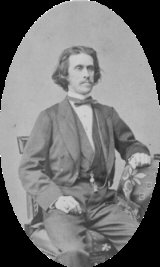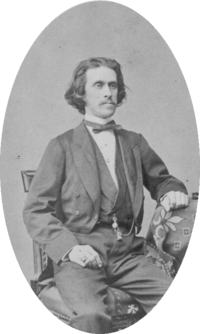
Josef Strauss
Encyclopedia

Austria
Austria , officially the Republic of Austria , is a landlocked country of roughly 8.4 million people in Central Europe. It is bordered by the Czech Republic and Germany to the north, Slovakia and Hungary to the east, Slovenia and Italy to the south, and Switzerland and Liechtenstein to the...
n composer
Composer
A composer is a person who creates music, either by musical notation or oral tradition, for interpretation and performance, or through direct manipulation of sonic material through electronic media...
.
He was born in Vienna
Vienna
Vienna is the capital and largest city of the Republic of Austria and one of the nine states of Austria. Vienna is Austria's primary city, with a population of about 1.723 million , and is by far the largest city in Austria, as well as its cultural, economic, and political centre...
, the son of Johann Strauss I
Johann Strauss I
Johann Strauss I , born in Vienna, was an Austrian Romantic composer famous for his waltzes, and for popularizing them alongside Joseph Lanner, thereby setting the foundations for his sons to carry on his musical dynasty...
and Maria Anna Streim, and brother of Johann Strauss II
Johann Strauss II
Johann Strauss II , also known as Johann Baptist Strauss or Johann Strauss, Jr., the Younger, or the Son , was an Austrian composer of light music, particularly dance music and operettas. He composed over 500 waltzes, polkas, quadrilles, and other types of dance music, as well as several operettas...
and Eduard Strauss
Eduard Strauss
Eduard Strauss was an Austrian composer who, together with brothers Johann Strauss II and Josef Strauss made up the Strauss musical dynasty. The family dominated the Viennese light music world for decades, creating many waltzes and polkas for many Austrian nobility as well as dance-music...
. His father wanted him to choose a career in the Austria
Austria
Austria , officially the Republic of Austria , is a landlocked country of roughly 8.4 million people in Central Europe. It is bordered by the Czech Republic and Germany to the north, Slovakia and Hungary to the east, Slovenia and Italy to the south, and Switzerland and Liechtenstein to the...
n Habsburg
Habsburg
The House of Habsburg , also found as Hapsburg, and also known as House of Austria is one of the most important royal houses of Europe and is best known for being an origin of all of the formally elected Holy Roman Emperors between 1438 and 1740, as well as rulers of the Austrian Empire and...
military. He studied music with Franz Dolleschal and learned to play the violin with Franz Anton Ries
Franz Anton Ries
Franz Anton Xaverius Ries was a German violinist. His father Johann Ries was court trumpeter to the Elector of Cologne in Bonn....
.
He received training as an engineer, and worked for the city of Vienna as an engineer and designer. He designed a horse-drawn revolving brush street-sweeping vehicle and published two textbooks on mathematical subjects. Strauss had talents as an artist, painter, poet, dramatist, singer, composer and inventor.
Family orchestra
He joined the family orchestra, along with his brothers, Johann Strauss IIJohann Strauss II
Johann Strauss II , also known as Johann Baptist Strauss or Johann Strauss, Jr., the Younger, or the Son , was an Austrian composer of light music, particularly dance music and operettas. He composed over 500 waltzes, polkas, quadrilles, and other types of dance music, as well as several operettas...
and Eduard Strauss
Eduard Strauss
Eduard Strauss was an Austrian composer who, together with brothers Johann Strauss II and Josef Strauss made up the Strauss musical dynasty. The family dominated the Viennese light music world for decades, creating many waltzes and polkas for many Austrian nobility as well as dance-music...
in the 1850s. His first published work was called "Die Ersten und Letzten" (The First and the Last). When the Johann became seriously ill in 1853 Josef led the orchestra for a while. The waltz-loving Viennese were appreciative of his early compositions so he decided to continue in the family tradition of composing dance music. He was known as 'Pepi' by his family and close friends, and Johann once said of him: "Pepi is the more gifted of us two; I am merely the more popular..."
Family life
Josef Strauss married Caroline Pruckmayer at the church of St. Johann Nepomuk in ViennaVienna
Vienna is the capital and largest city of the Republic of Austria and one of the nine states of Austria. Vienna is Austria's primary city, with a population of about 1.723 million , and is by far the largest city in Austria, as well as its cultural, economic, and political centre...
on 8 June 1857, and had one daughter, Karoline Anna, who was born in March 1858.
Music
Josef Strauss wrote 283 opus numbers. He wrote many waltzWaltz
The waltz is a ballroom and folk dance in time, performed primarily in closed position.- History :There are several references to a sliding or gliding dance,- a waltz, from the 16th century including the representations of the printer H.S. Beheim...
es, including: Sphären-Klänge (Music of the Spheres), Delirien (Deliriums), Transaktionen (Transactions), Mein Lebenslauf ist Lieb' und Lust (My Character is Love and Joy), and Dorfschwalben aus Österreich (Village Swallows from Austria), polka
Polka
The polka is a Central European dance and also a genre of dance music familiar throughout Europe and the Americas. It originated in the middle of the 19th century in Bohemia...
s, most famously the Pizzicato
Pizzicato
Pizzicato is a playing technique that involves plucking the strings of a string instrument. The exact technique varies somewhat depending on the type of stringed instrument....
Polka with his brother Johann, quadrille
Quadrille
Quadrille is a historic dance performed by four couples in a square formation, a precursor to traditional square dancing. It is also a style of music...
s, and other dance music. The waltz The Mysterious Powers of Magnetism (Dynamiden) with the use of minor keys showed a quality that distinguished his waltzes from those of his more popular elder brother. The polka-mazurka
Polka-mazurka
The polka-mazurek is a dance, musically similar to the mazurek, but danced much like the polka. Many polka-mazurek's were composed by Johann Strauss II and his family. Johann Strauss I did not compose any of this type of music; the first polka-mazurek example written by the Strauss family was in...
shows influence by Strauss, where he wrote many examples like Die Emancipierte and Die Libelle.
Death
Josef Strauss was sickly most of his life. He suffered fainting spells and intense headaches. During a tour to PolandPoland
Poland , officially the Republic of Poland , is a country in Central Europe bordered by Germany to the west; the Czech Republic and Slovakia to the south; Ukraine, Belarus and Lithuania to the east; and the Baltic Sea and Kaliningrad Oblast, a Russian exclave, to the north...
in 1870, he fell unconscious from the conductor's podium while conducting his 'Musical Potpourri'. It is not sure if he fainted and hit his head or simply became unconscious. His wife brought him back home to Vienna, to the Hirschenhaus, where on 22 July 1870 the engineer, designer, musician, and composer died. A final diagnosis only reported a decomposition of blood. There were rumors that he was beaten by drunken Russian soldiers after he allegedly refused to perform music for them one night. His cause of death was not determined as his widow forbade an autopsy. Originally buried in the St. Marx cemetery
St. Marx cemetery
St. Marx Cemetery is a cemetery in the Landstraße district of Vienna, used from 1784 until 1874. It was named after a nearby almshouse.-History:...
, Strauss was later exhumed and reburied in the Vienna Central Cemetery
Zentralfriedhof
The Zentralfriedhof is one of the largest cemeteries in the world, largest by number of interred in Europe and most famous cemetery among Vienna's nearly 50 cemeteries.-Name and location:...
, alongside his mother Anna. His dance pieces might have surpassed that of his older brother, had he survived, as Johann was by then concentrating on writing music for operetta
Operetta
Operetta is a genre of light opera, light in terms both of music and subject matter. It is also closely related, in English-language works, to forms of musical theatre.-Origins:...
s and other stage works.
Works of Josef Strauss
- The works of Josef Strauss include:
- Die Ersten und Letzten ('The First and the Last') waltz op. 1 (1853)
- Die Ersten nach den Letzten ('The First after the Last') waltz op. 12 (1854)
- Die Guten, Alten Zeiten ('The Good Old Times') waltz op. 26 (1856)
- Perlen der Liebe ('Pearls of Love') concert-waltz op. 39 (1857)
- Moulinet ('Little Mill Pond') polka-mazurka op. 57 (1858)
- Sympathie ('Sympathy') polka-mazurka op. 73 (1859)
- Lustschwärmer ('Joy Seeker') waltz op. 91 (1860)
- Wiener Bonmots ('Viennese Bon-mots') waltz op. 108 (1861)
- Winterlust ('Winter Joy') polka op. 121 (1862)
- Auf Ferienreisen! ('On a Holiday!') polka op. 133 (1863)
- Die Schwätzerin ('The Gossip') polka-mazurka op. 144 (1863)
- Wiener Couplets ('Viennese Couplets') waltz op. 150 (1863)
- Dorfschwalben aus Österreich ('Village Swallows from Austria') waltz op. 164 (1864) -Arguable his most famous.
- Frauenherz ('A Woman's Heart') polka-mazurka op. 166 (1864)
- Sport-Polka op. 170 (1864)
- Geheimne Anziehungskräfte (Dynamiden) ('Mysterious Powers of Magnetism') waltz op. 173 (1865)
- Stiefmütterchen ('Pansies') polka-mazurka op. 183 (1865)
- Transaktionen ('Transactions') waltz op. 184 (1865)
- Die Marketenderin ('The Camp Follower') polka op. 202 (1866)
- Die Libelle ('The Dragonfly') polka-mazurka op. 204 (1866)
- Delirien ('Deliriums') waltz op. 212 (1867)
- Sphären-Klänge ('Music of the Spheres') op. 235 (1868)
- Eingesendet ('Letters to the Editor') polka op. 240 (1868)
- Plappermäulchen ('Chatterboxes') polka op. 245 (1868)
- Aquarellen ('Watercolours') waltz op. 258 (1869)
- Eislauf ('Ice-Skating') polka op. 261 (1869)
- Mein Lebenslauf Ist Lieb` Und Lust! ('My Character is Love and Joy') waltz op. 263 (1869)
- Die Tanzende Muse ('The Dancing Muse') polka-mazurka op. 266 (1869)
- Feuerfest! ('Fire-Proof!') polka op. 269 (1869)
- Ohne Sorgen! ('Without a Care!') polka op. 271 (1869)
- Nilfluthen ('Nile's Waters') waltz op. 275 (1870)
- Jokey ('Jockey') polka op. 278 (1870)
- Die Emancipierte ('The Emancipated Woman') polka-mazurka op. 282 (1870)

